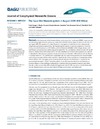Identificador persistente para citar o vincular este elemento:
https://accedacris.ulpgc.es/handle/10553/51627
| DC Field | Value | Language |
|---|---|---|
| dc.contributor.author | Sangrá Inciarte, Pablo | en_US |
| dc.contributor.author | Troupin, Charles | en_US |
| dc.contributor.author | Barreiro-González, Beatriz | en_US |
| dc.contributor.author | Desmond Barton, Eric | en_US |
| dc.contributor.author | Orbi, Abdellatif | en_US |
| dc.contributor.author | Arístegui, Javier | en_US |
| dc.contributor.other | Aristegui, Javier | - |
| dc.contributor.other | Sangra, Pablo | - |
| dc.contributor.other | ORBI, ABDELLATIF | - |
| dc.contributor.other | Troupin, Charles | - |
| dc.date.accessioned | 2018-11-25T02:18:30Z | - |
| dc.date.available | 2018-11-25T02:18:30Z | - |
| dc.date.issued | 2015 | en_US |
| dc.identifier.issn | 2169-9275 | en_US |
| dc.identifier.uri | https://accedacris.ulpgc.es/handle/10553/51627 | - |
| dc.description.abstract | In the framework of the Canaries‐Iberian marine ecosystem Exchanges (CAIBEX) experiment, an interdisciplinary high‐resolution survey was conducted in the NW African region of Cape Ghir (30°38′N) during August 2009. The anatomy of a major filament is investigated on scales down to the submesoscale using in situ and remotely sensed data. The filament may be viewed as a system composed of three intimately connected structures: a small, shallow, and cold filament embedded within a larger, deeper, and cool filament and an intrathermocline anticyclonic eddy (ITE). The cold filament, which stretches 110 km offshore, is a shallow feature 60 m deep and 25 km wide, identified by minimal surface temperatures and rich in chlorophyll a. This structure comprises two asymmetrical submesoscale (∼18 km) fronts with jets flowing in opposite directions. The cold filament is embedded near the equatorward boundary of a much broader region of approximately 120 km width and 150 m depth that forms the cool filament and stretches at least 200 km offshore. This cool region, partly resulting from the influence of cold filament, is limited by two asymmetrical mesoscale (∼50 km) frontal boundaries. At the ITE, located north of the cold filament, we observe evidence of downwelling as indicated by a relatively high concentration of particles extending from the surface to more than 200 m depth. We hypothesize that this ITE may act as a sink of carbon and thus the filament system may serve dual roles of offshore carbon export and carbon sink. | en_US |
| dc.language | eng | en_US |
| dc.publisher | 2169-9275 | |
| dc.relation.ispartof | Journal of geophysical research. Oceans | en_US |
| dc.source | Journal of Geophysical Research C: Oceans [ISSN 2169-9275], v. 120, p. 4516-4533 | en_US |
| dc.subject | 251001 Oceanografía biológica | en_US |
| dc.subject.other | Cape Ghir | en_US |
| dc.subject.other | Cold filament | en_US |
| dc.subject.other | Cool filament | en_US |
| dc.subject.other | Intrathermocline eddy | en_US |
| dc.subject.other | Submesoscale | en_US |
| dc.title | The Cape Ghir filament system in August 2009 (NW Africa) | en_US |
| dc.type | info:eu-repo/semantics/Article | en_US |
| dc.type | Article | en_US |
| dc.identifier.doi | 10.1002/2014JC010514 | |
| dc.identifier.scopus | 84937127941 | - |
| dc.identifier.isi | 000358124100034 | - |
| dcterms.isPartOf | Journal Of Geophysical Research-Oceans | |
| dcterms.source | Journal Of Geophysical Research-Oceans[ISSN 2169-9275],v. 120 (6), p. 4516-4533 | |
| dc.contributor.authorscopusid | 55938118400 | - |
| dc.contributor.authorscopusid | 35275999400 | - |
| dc.contributor.authorscopusid | 56724218700 | - |
| dc.contributor.authorscopusid | 56724190600 | - |
| dc.contributor.authorscopusid | 55409027900 | - |
| dc.contributor.authorscopusid | 7006816204 | - |
| dc.description.lastpage | 4533 | - |
| dc.description.firstpage | 4516 | - |
| dc.relation.volume | 120 | - |
| dc.investigacion | Ciencias | en_US |
| dc.type2 | Artículo | en_US |
| dc.contributor.daisngid | 763696 | - |
| dc.contributor.daisngid | 2075539 | - |
| dc.contributor.daisngid | 20774937 | - |
| dc.contributor.daisngid | 229386 | - |
| dc.contributor.daisngid | 2309784 | - |
| dc.contributor.daisngid | 227201 | - |
| dc.identifier.investigatorRID | D-5833-2013 | - |
| dc.identifier.investigatorRID | No ID | - |
| dc.identifier.investigatorRID | No ID | - |
| dc.identifier.investigatorRID | No ID | - |
| dc.utils.revision | Sí | en_US |
| dc.contributor.wosstandard | WOS:Sangra, P | |
| dc.contributor.wosstandard | WOS:Troupin, C | |
| dc.contributor.wosstandard | WOS:Barreiro-Gonzalez, B | |
| dc.contributor.wosstandard | WOS:Barton, ED | |
| dc.contributor.wosstandard | WOS:Orbi, A | |
| dc.contributor.wosstandard | WOS:Aristegui, J | |
| dc.date.coverdate | Junio 2015 | |
| dc.identifier.ulpgc | Sí | es |
| dc.description.jcr | 3,318 | |
| dc.description.jcrq | Q1 | |
| item.grantfulltext | open | - |
| item.fulltext | Con texto completo | - |
| crisitem.author.dept | GIR IOCAG: Oceanografía Biológica y Algología Aplicada | - |
| crisitem.author.dept | IU de Oceanografía y Cambio Global | - |
| crisitem.author.dept | Departamento de Biología | - |
| crisitem.author.orcid | 0000-0002-7526-7741 | - |
| crisitem.author.parentorg | IU de Oceanografía y Cambio Global | - |
| crisitem.author.fullName | Sangrá Inciarte, Pablo | - |
| crisitem.author.fullName | Arístegui Ruiz, Javier | - |
| Appears in Collections: | Artículos | |
SCOPUSTM
Citations
13
checked on Jun 8, 2025
WEB OF SCIENCETM
Citations
14
checked on Jun 8, 2025
Page view(s)
102
checked on Nov 16, 2024
Download(s)
170
checked on Nov 16, 2024
Google ScholarTM
Check
Altmetric
Share
Export metadata
Items in accedaCRIS are protected by copyright, with all rights reserved, unless otherwise indicated.
